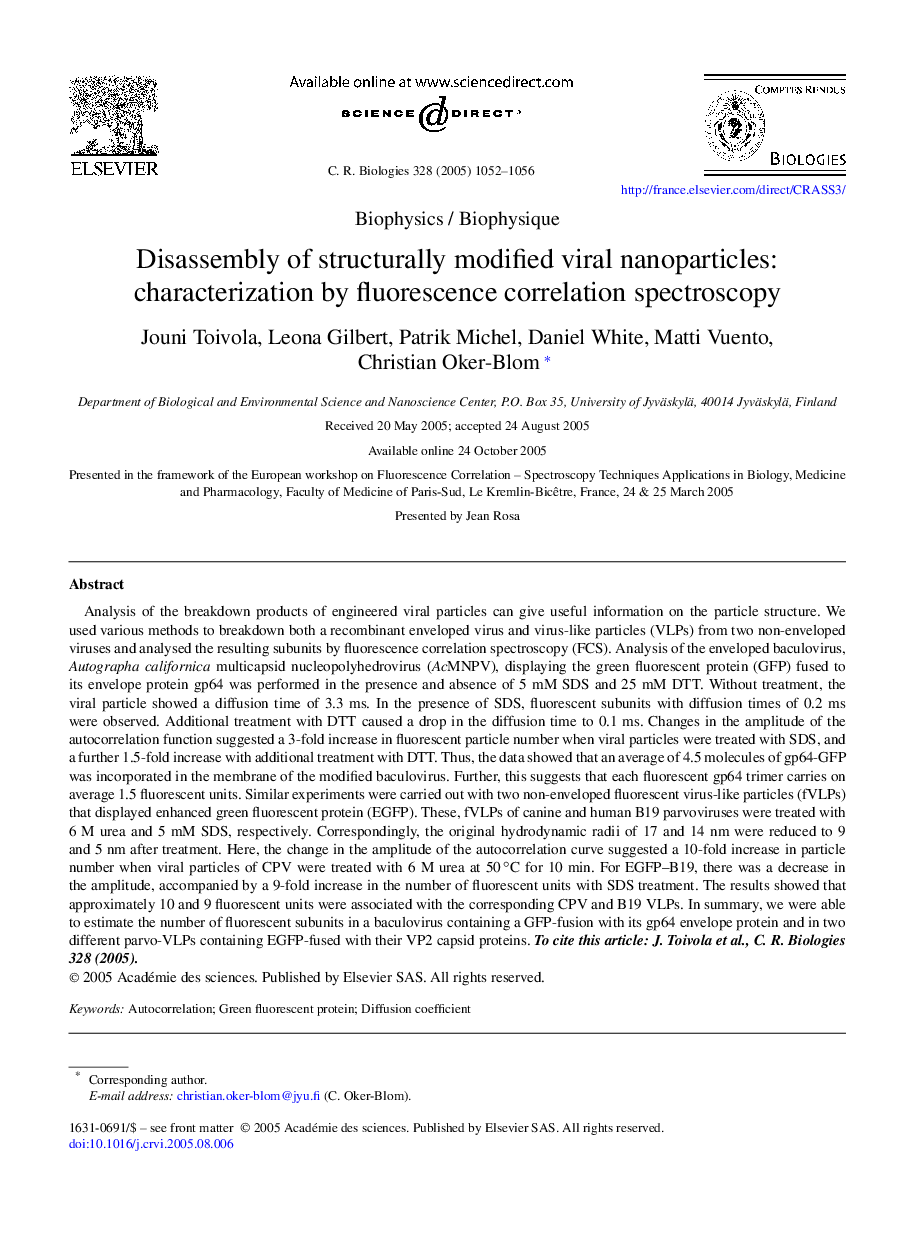| کد مقاله | کد نشریه | سال انتشار | مقاله انگلیسی | نسخه تمام متن |
|---|---|---|---|---|
| 9106849 | 1153862 | 2005 | 5 صفحه PDF | دانلود رایگان |
عنوان انگلیسی مقاله ISI
Disassembly of structurally modified viral nanoparticles: characterization by fluorescence correlation spectroscopy
دانلود مقاله + سفارش ترجمه
دانلود مقاله ISI انگلیسی
رایگان برای ایرانیان
کلمات کلیدی
موضوعات مرتبط
علوم زیستی و بیوفناوری
علوم کشاورزی و بیولوژیک
علوم کشاورزی و بیولوژیک (عمومی)
پیش نمایش صفحه اول مقاله

چکیده انگلیسی
Analysis of the breakdown products of engineered viral particles can give useful information on the particle structure. We used various methods to breakdown both a recombinant enveloped virus and virus-like particles (VLPs) from two non-enveloped viruses and analysed the resulting subunits by fluorescence correlation spectroscopy (FCS). Analysis of the enveloped baculovirus, Autographa californica multicapsid nucleopolyhedrovirus (AcMNPV), displaying the green fluorescent protein (GFP) fused to its envelope protein gp64 was performed in the presence and absence of 5 mM SDS and 25 mM DTT. Without treatment, the viral particle showed a diffusion time of 3.3 ms. In the presence of SDS, fluorescent subunits with diffusion times of 0.2 ms were observed. Additional treatment with DTT caused a drop in the diffusion time to 0.1 ms. Changes in the amplitude of the autocorrelation function suggested a 3-fold increase in fluorescent particle number when viral particles were treated with SDS, and a further 1.5-fold increase with additional treatment with DTT. Thus, the data showed that an average of 4.5 molecules of gp64-GFP was incorporated in the membrane of the modified baculovirus. Further, this suggests that each fluorescent gp64 trimer carries on average 1.5 fluorescent units. Similar experiments were carried out with two non-enveloped fluorescent virus-like particles (fVLPs) that displayed enhanced green fluorescent protein (EGFP). These, fVLPs of canine and human B19 parvoviruses were treated with 6 M urea and 5 mM SDS, respectively. Correspondingly, the original hydrodynamic radii of 17 and 14 nm were reduced to 9 and 5 nm after treatment. Here, the change in the amplitude of the autocorrelation curve suggested a 10-fold increase in particle number when viral particles of CPV were treated with 6 M urea at 50â°C for 10 min. For EGFP-B19, there was a decrease in the amplitude, accompanied by a 9-fold increase in the number of fluorescent units with SDS treatment. The results showed that approximately 10 and 9 fluorescent units were associated with the corresponding CPV and B19 VLPs. In summary, we were able to estimate the number of fluorescent subunits in a baculovirus containing a GFP-fusion with its gp64 envelope protein and in two different parvo-VLPs containing EGFP-fused with their VP2 capsid proteins. To cite this article: J. Toivola et al., C. R. Biologies 328 (2005).
ناشر
Database: Elsevier - ScienceDirect (ساینس دایرکت)
Journal: Comptes Rendus Biologies - Volume 328, Issue 12, December 2005, Pages 1052-1056
Journal: Comptes Rendus Biologies - Volume 328, Issue 12, December 2005, Pages 1052-1056
نویسندگان
Jouni Toivola, Leona Gilbert, Patrik Michel, Daniel White, Matti Vuento, Christian Oker-Blom,